Science 5463 - Study guides, Class notes & Summaries
Looking for the best study guides, study notes and summaries about Science 5463? On this page you'll find 113 study documents about Science 5463.
Page 4 out of 113 results
Sort by
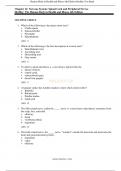
-
Chapter 11: Nervous System: Spinal Cord and Peripheral Nerves Herlihy: The Human Body in Health and Illness, 6th Edition
- Exam (elaborations) • 12 pages • 2024
-
- $8.99
- + learn more
Chapter 11: Nervous System: Spinal Cord and Peripheral Nerves Herlihy: The Human Body in Health and Illness, 6th Edition MULTIPLE CHOICE 1. Which of the following is the major motor tract? a. Cauda equina b. Spinocerebellar c. Pyramidal d. Spinothalamic ANS: C 2. Which of the following is the best description of a motor tract? a. Spinothalamic tract b. Ascending tract c. Descending tract d. Gray matter ANS: C 3. To achieve spinal anesthesia, a -caine drug is injected into the a. ...
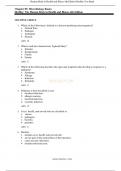
-
Chapter 05: Microbiology Basics Herlihy: The Human Body in Health and Illness, 6th Edition
- Exam (elaborations) • 10 pages • 2024
-
- $8.99
- + learn more
Chapter 05: Microbiology Basics Herlihy: The Human Body in Health and Illness, 6th Edition MULTIPLE CHOICE 1. Which of the following is defined as a disease-producing microorganism? a. Normal flora b. Pathogen c. Arthropod d. Parasite ANS: B 2. Which word best characterizes Typhoid Mary? a. Immune b. Symptomatic c. Carrier d. Fomite ANS: C 3. Which of the following describes the signs and symptoms that develop in response to a pathogen? a. Syndrome b. Allergy c. Infection d. ...
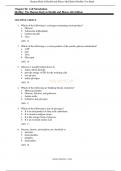
-
Chapter 04: Cell Metabolism Herlihy: The Human Body in Health and Illness, 6th Edition
- Case • 11 pages • 2024
-
- $8.99
- + learn more
Chapter 04: Cell Metabolism Herlihy: The Human Body in Health and Illness, 6th Edition MULTIPLE CHOICE 1. Which of the following is a nitrogen-containing waste product? a. Glucose b. Adenosine triphosphate c. Carbon dioxide d. Urea ANS: D 2. Which of the following is a waste product of the aerobic glucose metabolism? a. ATP b. CO2 c. Urea d. Glycogen ANS: B 3. Glucose is usually broken down to a. make carbon dioxide. b. provide energy (ATP) for the working cells. c. use up urea...

-
Chapter 12: Autonomic Nervous System Herlihy: The Human Body in Health and Illness, 6th Edition
- Exam (elaborations) • 7 pages • 2024
-
- $8.99
- + learn more
Chapter 12: Autonomic Nervous System Herlihy: The Human Body in Health and Illness, 6th Edition MULTIPLE CHOICE 1. Which of the following is most related to the “feed-and-breed” system? a. Pyramidal tracts b. Sympathetic nervous system c. Craniosacral outflow d. Rapid heart rate, palpitations, sweating ANS: C 2. Which of the following is most characteristic of the parasympathetic nervous system? a. Adrenergic b. Norepinephrine c. Fight-or-flight response d. Feed-and-breed system...
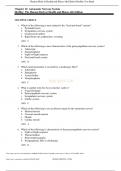
-
Chapter 12: Autonomic Nervous System Herlihy: The Human Body in Health and Illness, 6th Edition
- Exam (elaborations) • 7 pages • 2024
-
- $8.99
- + learn more
Chapter 12: Autonomic Nervous System Herlihy: The Human Body in Health and Illness, 6th Edition MULTIPLE CHOICE 1. Which of the following is most related to the “feed-and-breed” system? a. Pyramidal tracts b. Sympathetic nervous system c. Craniosacral outflow d. Rapid heart rate, palpitations, sweating ANS: C 2. Which of the following is most characteristic of the parasympathetic nervous system? a. Adrenergic b. Norepinephrine c. Fight-or-flight response d. Feed-and-breed system...
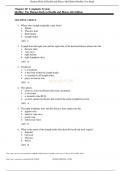
-
Chapter 20: Lymphatic System Herlihy: The Human Body in Health and Illness, 6th Edition
- Exam (elaborations) • 6 pages • 2024
-
- $8.99
- + learn more
Chapter 20: Lymphatic System Herlihy: The Human Body in Health and Illness, 6th Edition MULTIPLE CHOICE 1. Where does lymph originally come from? a. Spleen b. Thoracic duct c. Interstitium d. Lymph nodes ANS: C 2. Lymph from the right arm and the right side of the head and thorax drains into the a. thoracic duct. b. vena cava. c. right atrium. d. right lymphatic duct. ANS: D 3. Thymosin a. is a hormone. b. is the fluid within the lymph nodes. c. is secreted by all lymph nodes. ...
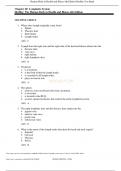
-
Chapter 20: Lymphatic System Herlihy: The Human Body in Health and Illness, 6th Edition
- Exam (elaborations) • 6 pages • 2024
-
- $8.99
- + learn more
Chapter 20: Lymphatic System Herlihy: The Human Body in Health and Illness, 6th Edition MULTIPLE CHOICE 1. Where does lymph originally come from? a. Spleen b. Thoracic duct c. Interstitium d. Lymph nodes ANS: C 2. Lymph from the right arm and the right side of the head and thorax drains into the a. thoracic duct. b. vena cava. c. right atrium. d. right lymphatic duct. ANS: D 3. Thymosin a. is a hormone. b. is the fluid within the lymph nodes. c. is secreted by all lymph nodes. ...
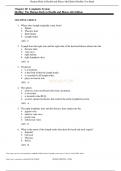
-
Chapter 20: Lymphatic System Herlihy: The Human Body in Health and Illness, 6th Edition
- Exam (elaborations) • 6 pages • 2024
-
- $8.99
- + learn more
Chapter 20: Lymphatic System Herlihy: The Human Body in Health and Illness, 6th Edition MULTIPLE CHOICE 1. Where does lymph originally come from? a. Spleen b. Thoracic duct c. Interstitium d. Lymph nodes ANS: C 2. Lymph from the right arm and the right side of the head and thorax drains into the a. thoracic duct. b. vena cava. c. right atrium. d. right lymphatic duct. ANS: D 3. Thymosin a. is a hormone. b. is the fluid within the lymph nodes. c. is secreted by all lymph nodes. ...
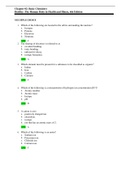
-
Chapter 02: Basic Chemistry Herlihy: The Human Body in Health and Illness, 6th Edition
- Exam (elaborations) • 11 pages • 2023
-
Available in package deal
-
- $3.00
- + learn more
1. Which of the following are located in the orbits surrounding the nucleus? a. Isotopes b. Protons c. Electrons d. Neutrons ANS: C 2. The sharing of electrons is referred to as a. covalent bonding. b. ionic bonding. c. radioactive decay. d. isotope formation. ANS: A 3. Which element must be present for a substance to be classified as organic? a. Iodine b. Iron c. Carbon d. Calcium ANS: C
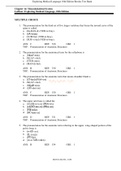
-
Chapter 14: Musculoskeletal System LaFleur: Exploring Medical Language, 10th Edition
- Exam (elaborations) • 22 pages • 2023
- Available in package deal
-
- $9.49
- + learn more
1. The pronunciation for the third set of five larger vertebrae that forms the inward curve of the spine is called a. (tha-RAS-ik) (VER-te-bray). b. c. (LUM-bar) (VER-te-bray). d. (SUR-vi-kal) (VER-te-bray). ANS: C REF: 530 OBJ: 1 TOP: Pronunciation of Anatomic Structures 2. The pronunciation for the anatomical term for the collarbone is a. b. (KLAV-i-kul). c. (STUR-num). d. (MAN-di-bul). ANS: B REF: 530 OBJ: 1 TOP: Pronunciation of Anatomic Structures 3. The pronunciation for the...

Study stress? For sellers on Stuvia, these are actually golden times. KA-CHING! Earn from your study resources too and start uploading now. Discover all about earning on Stuvia


